The Study on Single-Event Effects and Hardening Analysis of Frequency Divider Circuits Based on InP HBT Process
Abstract
1. Introduction
2. Transient Current Model of SEEs in InP HBT
3. Sensitive Structures and SEEs in Divider Circuits
3.1. Basic Functions of Circuits
3.2. Sensitive Structures in Divider Circuits
3.3. SEEs in the Divider Circuit
4. Hardening Analysis of the Divider Circuit
5. Conclusions
Author Contributions
Funding
Data Availability Statement
Conflicts of Interest
References
- Lee, J.; Baeyens, Y.; Weiner, J.; Chen, Y.-K. A 50GS/S distributed T/H amplifier in 0.18 μm SiGe BiCMOS. In Proceedings of the 2007 IEEE International Solid-State Circuits Conference, San Francisco, CA, USA, 11–15 February 2007; pp. 466–616. [Google Scholar]
- Ali, A.M.A.; Dinc, H.; Bhoraskar, P.; Bardsley, S.; Dillon, C.; McShea, M.; Periathambi, J.P.; Puckett, S. A 12-b 18-GS/s RF sampling ADC with an integrated wideband track-and-hold amplifier and background calibration. IEEE J. Solid State Circuits 2020, 55, 3210–3224. [Google Scholar] [CrossRef]
- Krupnik, Y.; Perelman, Y.; Levin, I.; Sanhedrai, Y.; Eitan, R.; Khairi, A.; Shifman, Y.; Landau, Y.; Virobnik, U.; Dolev, N.; et al. 112-Gb/s PAM4 ADC-based SERDES receiver with resonant AFE for long-reach channels. IEEE J. Solid State Circuits 2020, 55, 1077–1085. [Google Scholar] [CrossRef]
- Cheng, W.; Zhang, Y.T.; Wang, Y.; Lu, H.Y.; Zhao, Y.; Yang, N.B. Ultra High Speed Static and Dynamic Dividers in InP HBT Technology. Res. Prog. Solid State Electron. 2014, 34, 6. [Google Scholar]
- Fang, W. Accurate analytical delay expressions for ECL and CML circuits and their applications to optimizing high-speed bipolar circuits. IEEE J. Solid State Circuits 1990, 25, 572–583. [Google Scholar] [CrossRef]
- Alioto, M.; Palumbo, G. CML and ECL: Optimized design and comparison. IEEE Trans. Circuits Syst. I Fundam. Theory Appl. 1999, 46, 1330–1341. [Google Scholar] [CrossRef]
- Harrington, B.K. SPIL-a program to automatically create ASIC macro models for logic simulation. In Proceedings of the Third Annual IEEE Proceedings on ASIC Seminar and Exhibit, Rochester, NY, USA, 17–21 September 1990; pp. 5/5.1–5/5.4. [Google Scholar]
- Hansen, D.L.; Robinson, M.J.; Lu, F. Total-dose effects in InP devices. In Proceedings of the 2007 IEEE Radiation Effects Data Workshop, Honolulu, HI, USA, 23–27 July 2017; pp. 68–72. [Google Scholar]
- Zhang, X.; Li, Y.; Guo, Q.; Feng, J. Low energy proton irradiation effects on InP/InGaAs DHBTs and InP-base frequency dividers. In Proceedings of the Young Scientists Forum 2017, Shanghai, China, 24–26 November 2017; Volume 10710, pp. 65–70. [Google Scholar]
- Liu, M.; Zhang, Y.; Lü, H.; Zhang, Y. Simulated study on the InP/InGaAs DHBT under proton irradiation. J. Semicond. 2016, 37, 114005. [Google Scholar] [CrossRef]
- Zhao, M.L. Analysis of Irradiation-Induced Defects in InP/InGaAs Heterostructures. Master’s Dissertation, Xidian University, Xi’an, China, 2018. [Google Scholar]
- Zhang, X.; Li, Y.; Guo, Q.; Liao, B.; Yang, S.; Yang, Z.; He, C. Displacement damage effects and anneal characteristic on InP/InGaAs DHBTs. In Proceedings of the 2018 International Conference on Radiation Effects of Electronic Devices (ICREED), Beijing, China, 16–18 May 2018; pp. 1–5. [Google Scholar]
- Sun, Y.-B.; Fu, J.; Xu, J.; Wang, Y.-D.; Zhou, W.; Zhang, W.; Cui, J.; Li, G.-Q.; Liu, Z.-H.; Yu, Y.-T.; et al. A single-event transient induced by a pulsed laser in a silicon-germanium heterojunction bipolar transistor. Chin. Phys. B 2013, 22, 056103. [Google Scholar] [CrossRef]
- Varadharajaperumal, M.; Niu, G.; Cressler, J.D.; Reed, R.A.; Marshall, P.W. Three-dimensional simulation of heavy-ion induced charge collection in SiGe HBTs on SOI. IEEE Trans. Nucl. Sci. 2004, 51, 3298–3303. [Google Scholar] [CrossRef]
- Liang, B.; Song, R. Analyzing and mitigating the internal single-event transient in radiation hardened flip-flops at circuit-level. Sci. China Technol. Sci. 2014, 57, 1834–1839. [Google Scholar] [CrossRef]
- Niu, G.; Cressler, J.D.; Shoga, M.; Jobe, K.; Chu, P.; Harame, D.L. Simulation of SEE-induced charge collection in UHV/CVD SiGe HBTs. IEEE Trans. Nucl. Sci. 2000, 47, 2682–2689. [Google Scholar] [CrossRef]
- Song, R.; Shao, J.; Liang, B.; Chi, Y.; Chen, J. MSIFF: A radiation-hardened flip-flop via interleaving master-slave stage layout topology. IEICE Electron. Express 2020, 17, 20190708. [Google Scholar] [CrossRef]
- Liang, B.; Chen, J.; Chi, Y.; Yuan, H.; Wen, Y.; Yao, X.; Sun, H. SEE and TID characterization of an 8 Gbps SST transmitter in a 28 nm bulk CMOS technology. Microelectron. Reliab. 2023, 142, 114909. [Google Scholar] [CrossRef]
- Krithivasan, R.; Niu, G.; Cressler, J.D.; Currie, S.M.; Fritz, K.E.; Reed, R.A.; Marshall, P.W.; Riggs, P.A.; Randall, B.A.; Gilbert, B. An SEU hardening approach for high-speed SiGe HBT digital logic. IEEE Trans. Nucl. Sci. 2003, 50, 2126–2134. [Google Scholar] [CrossRef]
- Weatherford, T.R.; Schiefelbein, P.K. SEE analysis of digital InP-based HBT circuits at gigahertz frequencies. IEEE Trans. Nucl. Sci. 2001, 48, 1980–1986. [Google Scholar] [CrossRef]
- Hansen, D.L.; Chu, P.; Meyer, S.F. Effects of data rate and transistor size on single event upset cross-sections for InP-based circuits. IEEE Trans. Nucl. Sci. 2005, 52, 3166–3171. [Google Scholar] [CrossRef]
- Hansen, D.L.; Marshall, P.W.; Lopez-Aguado, R.; Jobe, K.; Carts, M.A.; Marshall, C.J.; Chu, P.; Meyer, S.F. A study of the SEU performance of InP and SiGe shift registers. IEEE Trans. Nucl. Sci. 2005, 52, 1140–1147. [Google Scholar] [CrossRef]
- Chu, P.; Hansen, D.L.; Doyle, B.L.; Jobe, K.; Lopez-Aguado, R.; Shoga, M.; Walsh, D.S. Ion-microbeam probe of high-speed shift registers for SEU Analysis-part II: InP. IEEE Trans. Nucl. Sci. 2006, 53, 1583–1592. [Google Scholar] [CrossRef]
- Zhang, Y.; Lv, H.; Zhang, Y.; Zhang, Y.; Zhao, X.; Li, S. Study on the hardening of single-event transient in D-type flip-flop based on InP HBT. In Proceedings of the 2020 IEEE 15th International Conference on Solid-State & Integrated Circuit Technology, Kunming, China, 3–6 November 2020; pp. 1–4. [Google Scholar]
- Zhao, X.-H.; Lu, H.-L.; Zhang, Y.-M.; Zhang, Y.-M.; Wei, Z.-C. The impact of laser energy, bias and irradiation positions on single event transients of InP HBT. J. Phys. D Appl. Phys. 2020, 53, 145104. [Google Scholar] [CrossRef]
- Wei, Z.C. Research of Single Event Effect in InP HBT Device. Master’s Dissertation, Xidian University, Xi’an, China, 2014. [Google Scholar]
- Jin, Z.; Su, Y.-B.; Cheng, W.; Liu, X.-Y.; Xu, A.-H.; Qi, M. High current multi-finger InGaAs/InP double heterojunction bipolar transistor with the maximum oscillation frequency 253 GHz. Chin. Phys. Lett. 2008, 25, 3075. [Google Scholar] [CrossRef]
- Zhen, W.; Li, S.; Cao, S.; Su, Y.; Jin, Z. A broadband high bandwidth utilization ECL static frequency divider in InP DHBT process. IEICE Electron. Express 2020, 17, 20200215. [Google Scholar] [CrossRef]
- Shi, Z. Design of High-Performance Dynamic Frequency Divider. Master’s Dissertation, Xidian University, Xi’an, China, 2014. [Google Scholar]
- Zhang, Y.; Li, X.; Zhang, M.; Cheng, W.; Chen, X. A 83 Ghz InP DHBT static frequency divider. J. Semicond. 2014, 35, 045004. [Google Scholar] [CrossRef]
- Zhang, M.; Meng, Q.; Zhang, Y.; Li, X.; Zhang, Y.; Cheng, W. A broad-band 1: 4 static frequency divider MMIC in InPHBT. In Proceedings of the 2019 IEEE 4th International Conference on Integrated Circuits and Microsystems, Beijing, China, 25–27 October 2019; pp. 242–245. [Google Scholar]
- Zhang, M.; Li, X.; Zhang, Y.; Cheng, W. 0.5~43GHz 1:2 Static Frequency Divider MMIC in InP HBT. In Proceedings of the 2019 International Conference on IC Design and Technology, Suzhou, China, 17–19 June 2019; pp. 1–3. [Google Scholar]
- Xiao, L.; Zhen, W.; Cao, S.; Su, Y.; Jin, Z. A broadband static frequency divider up to 62 GHz in InP DHBT with capacitive degeneration. IEICE Electron. Express 2022, 19, 20220117. [Google Scholar] [CrossRef]
- Su, Y.; Jin, Z.; Cheng, W.; Ge, J.; Wang, X.; Chen, G.; Liu, X.; Xu, A.; Qi, M. An InGaAs/InP 40 GHz CML static frequency divider. J. Semicond. 2011, 32, 035008. [Google Scholar] [CrossRef]
- Xiao, L.N. Microwave/Millimeter-Wave Integrated Circuit Design for Ultra-High-Speed Analog Front End System. Ph.D. Dissertation, Institute of Microelectronics, Chinese Academy of Sciences, Beijing, China, 2023. [Google Scholar]
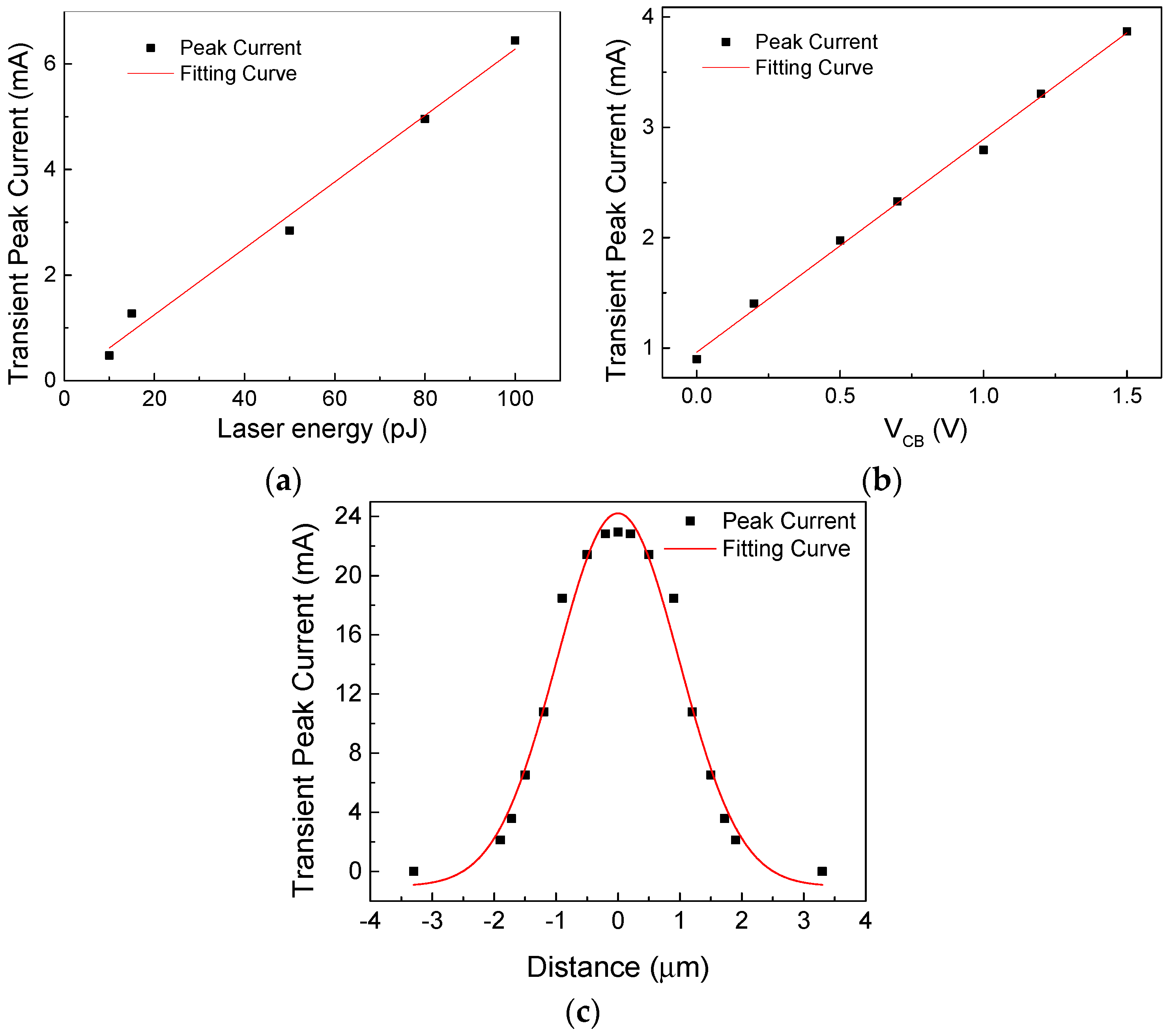
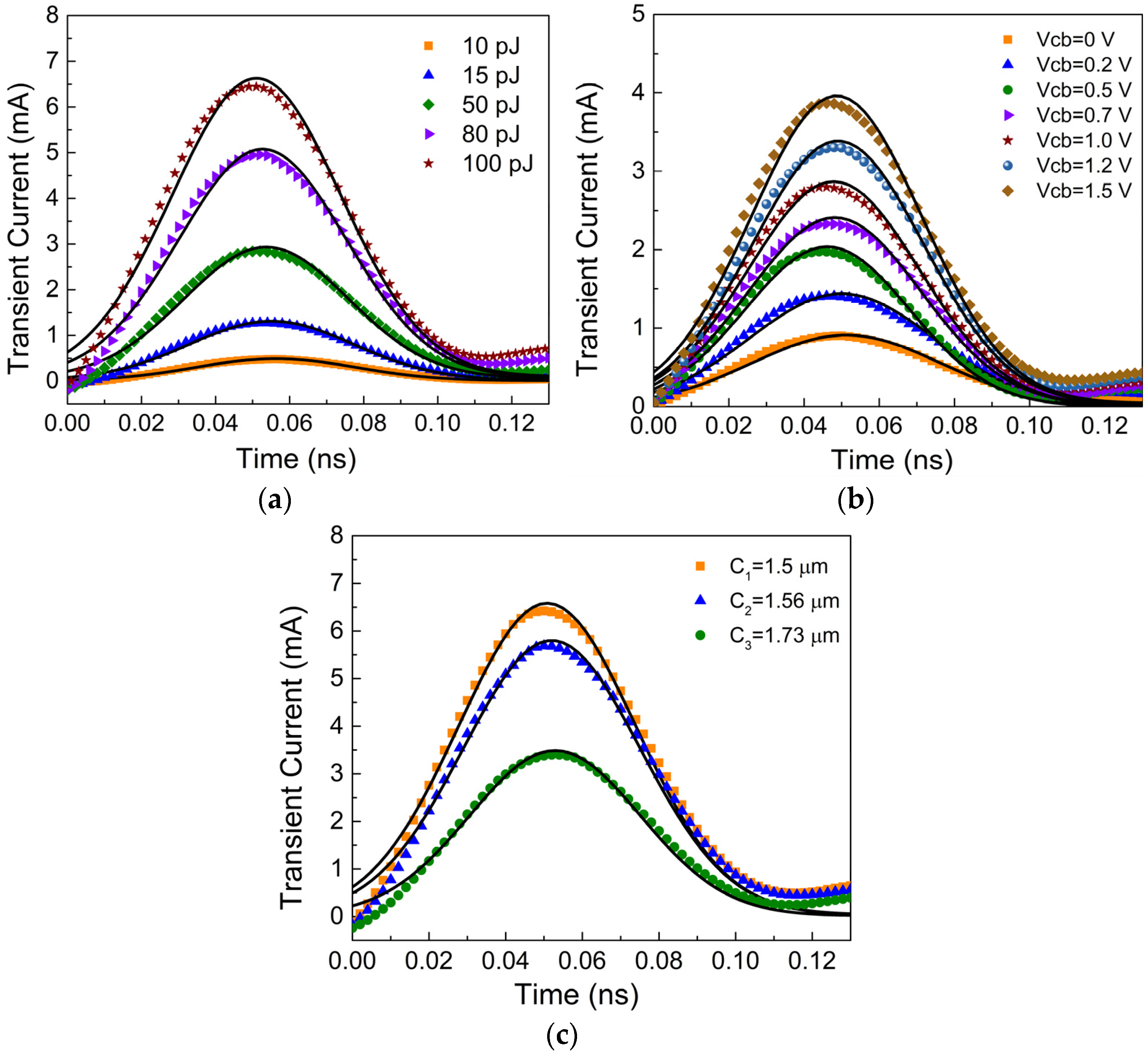
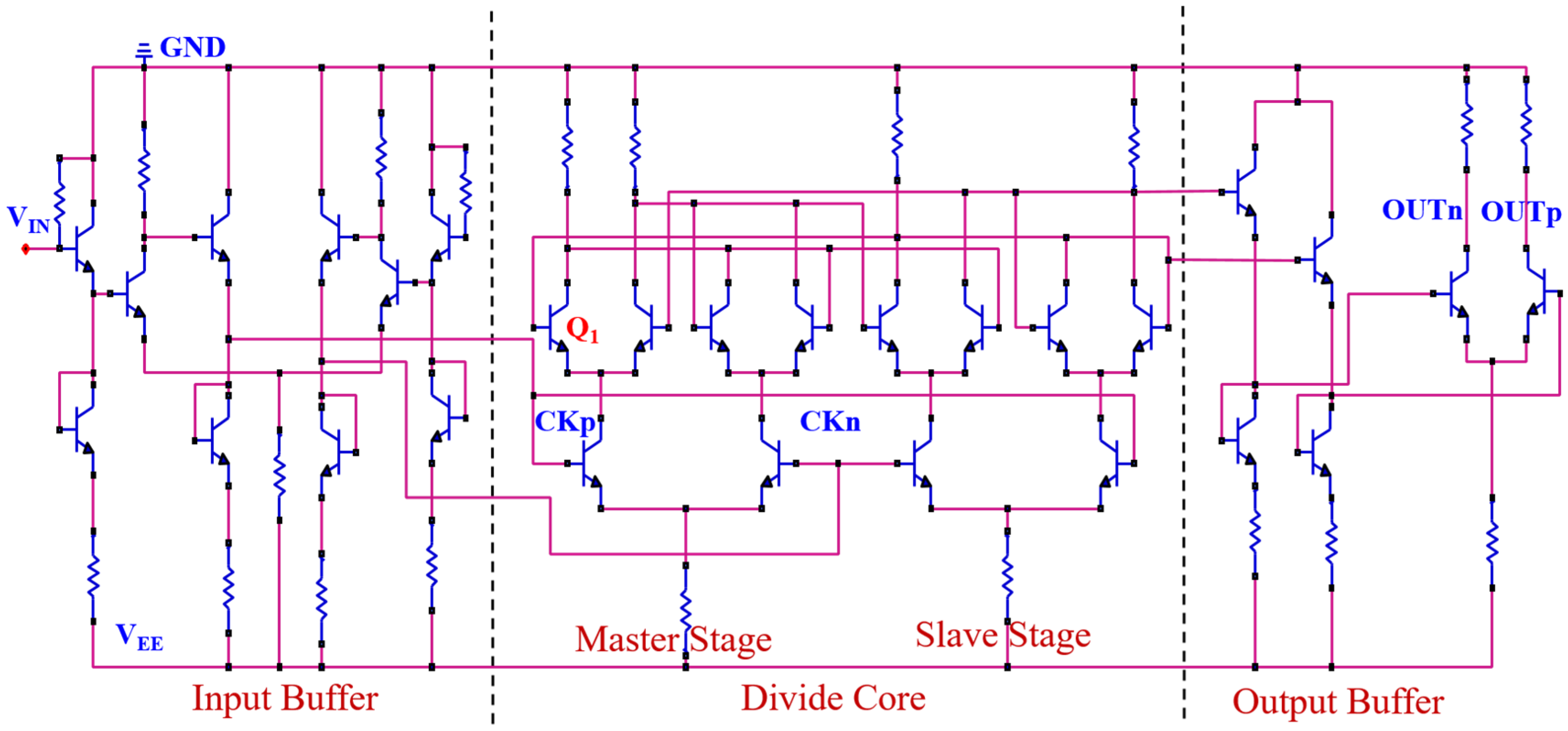
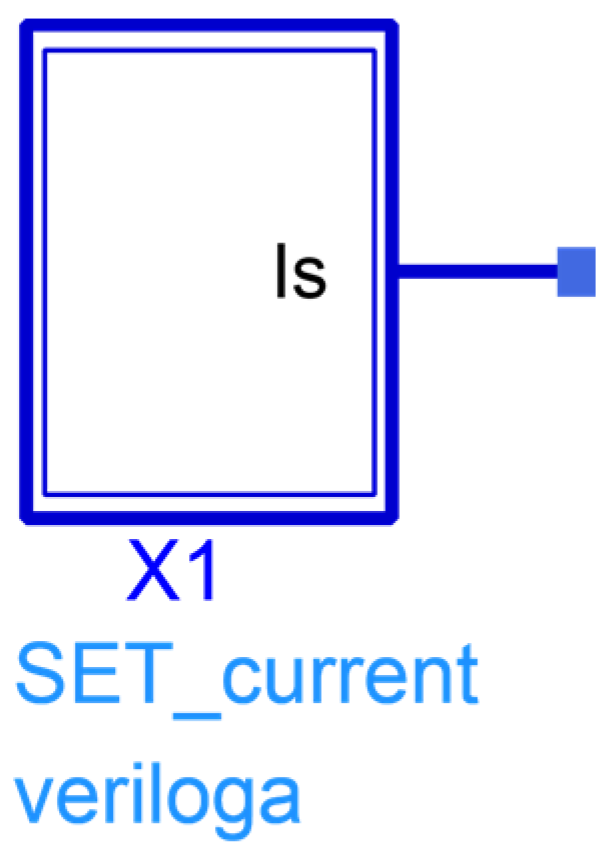
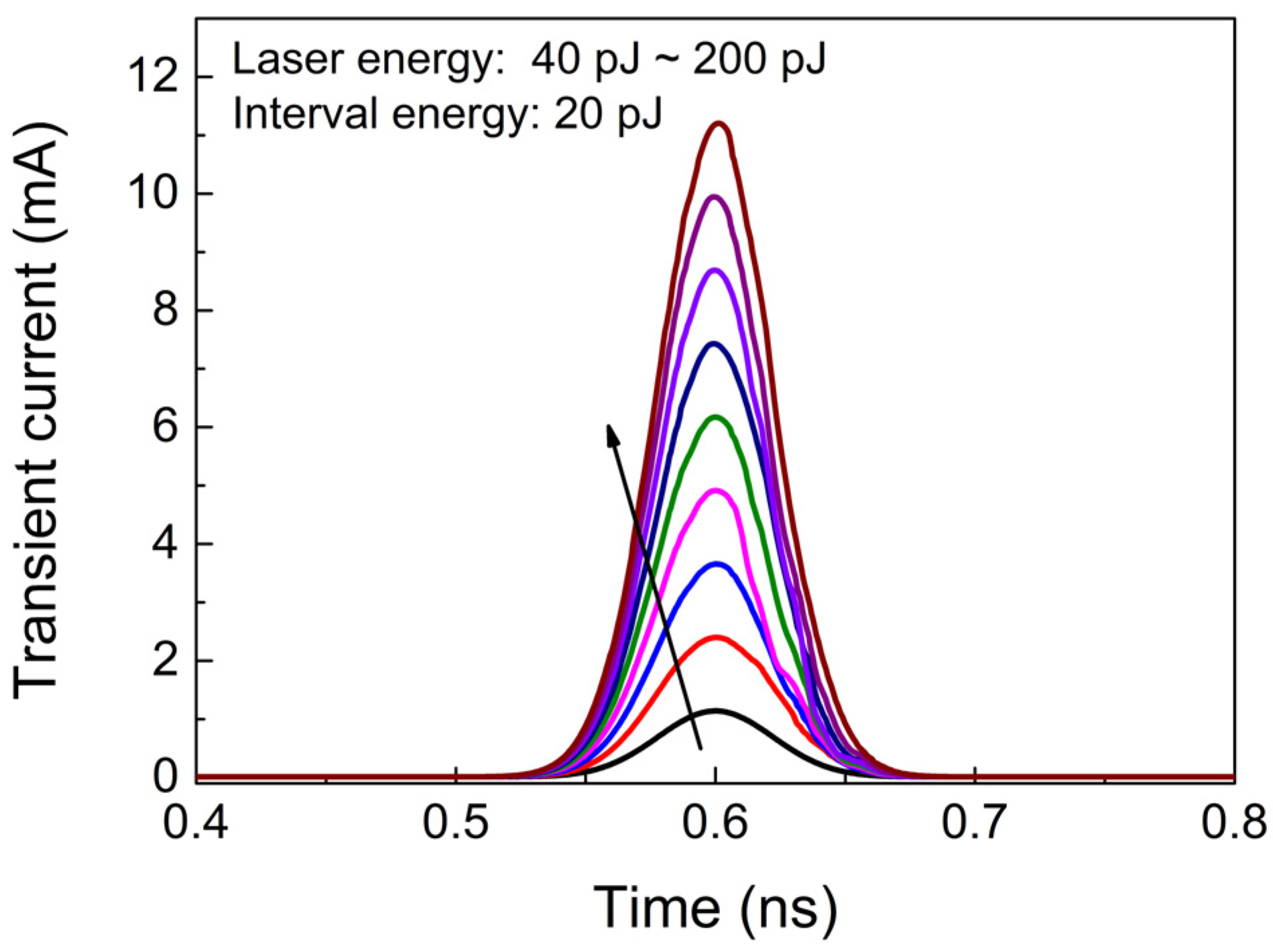


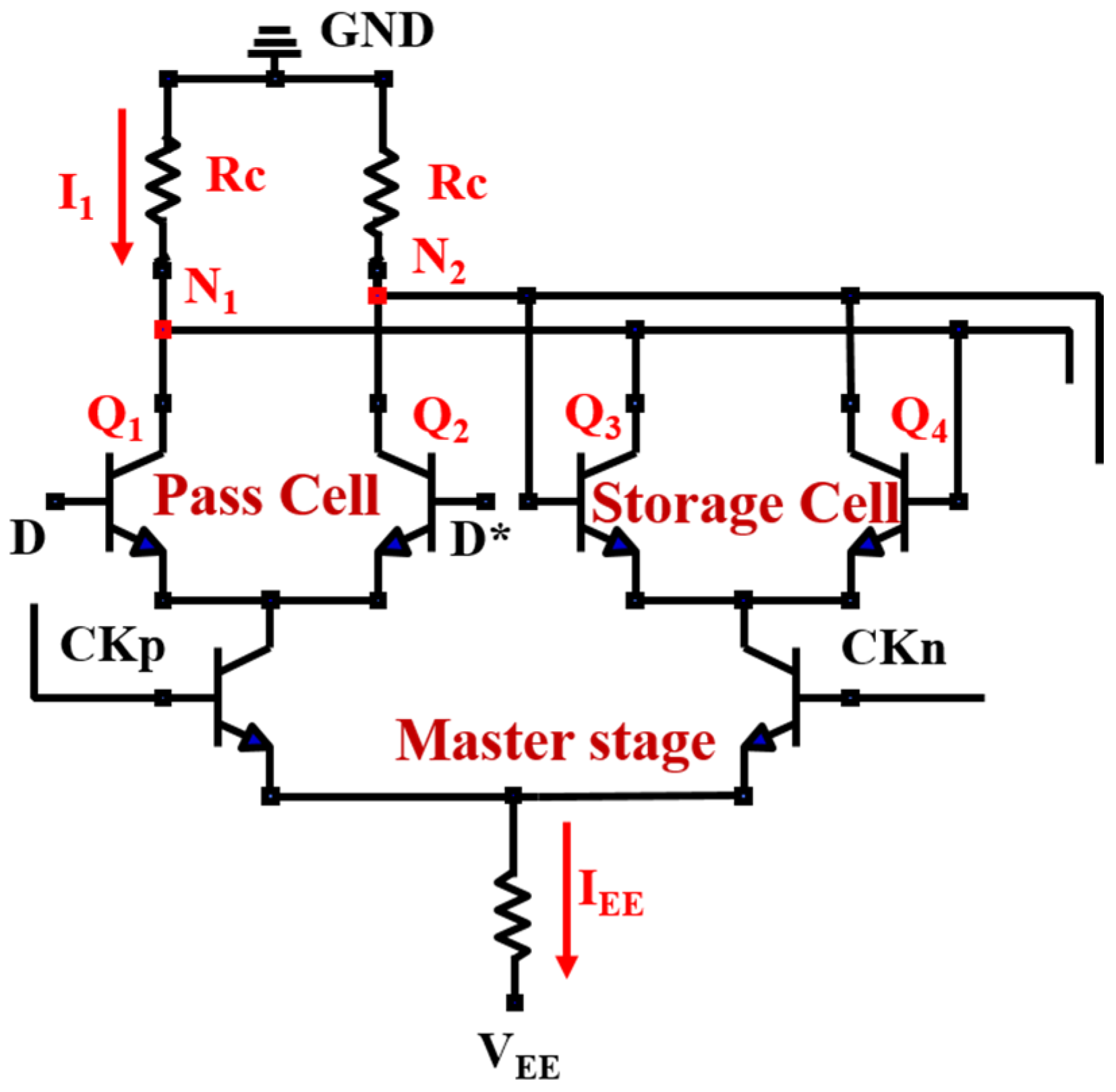
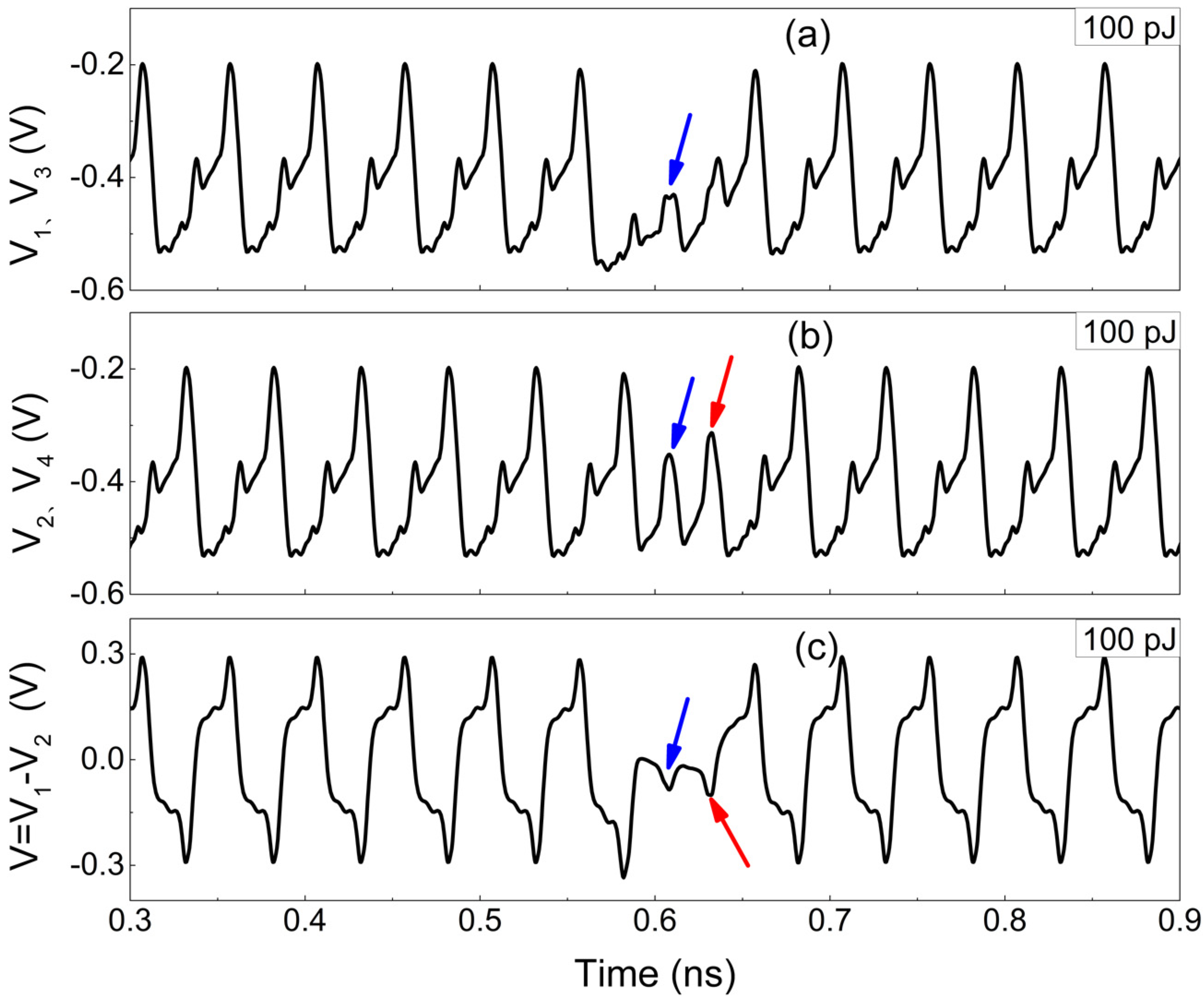
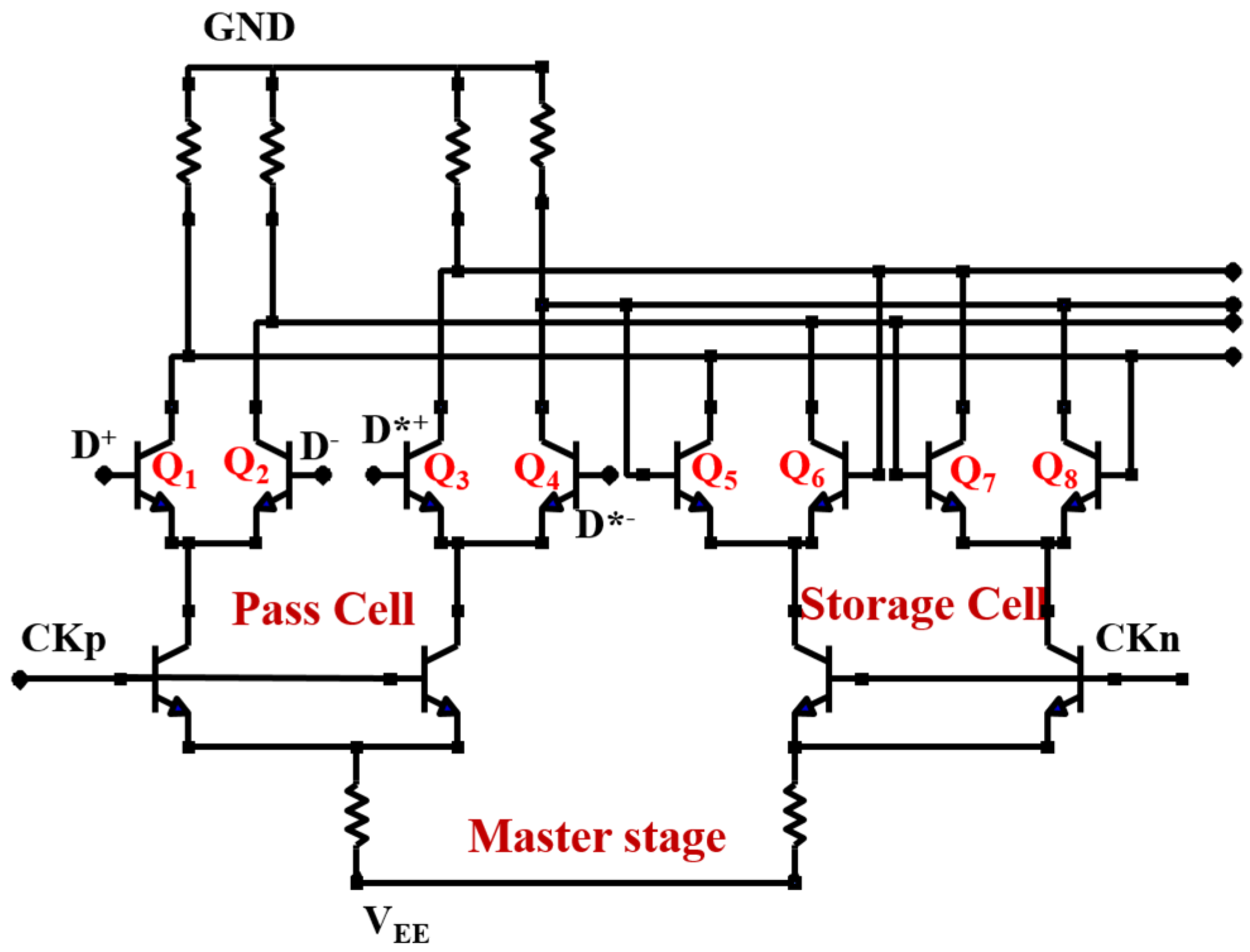
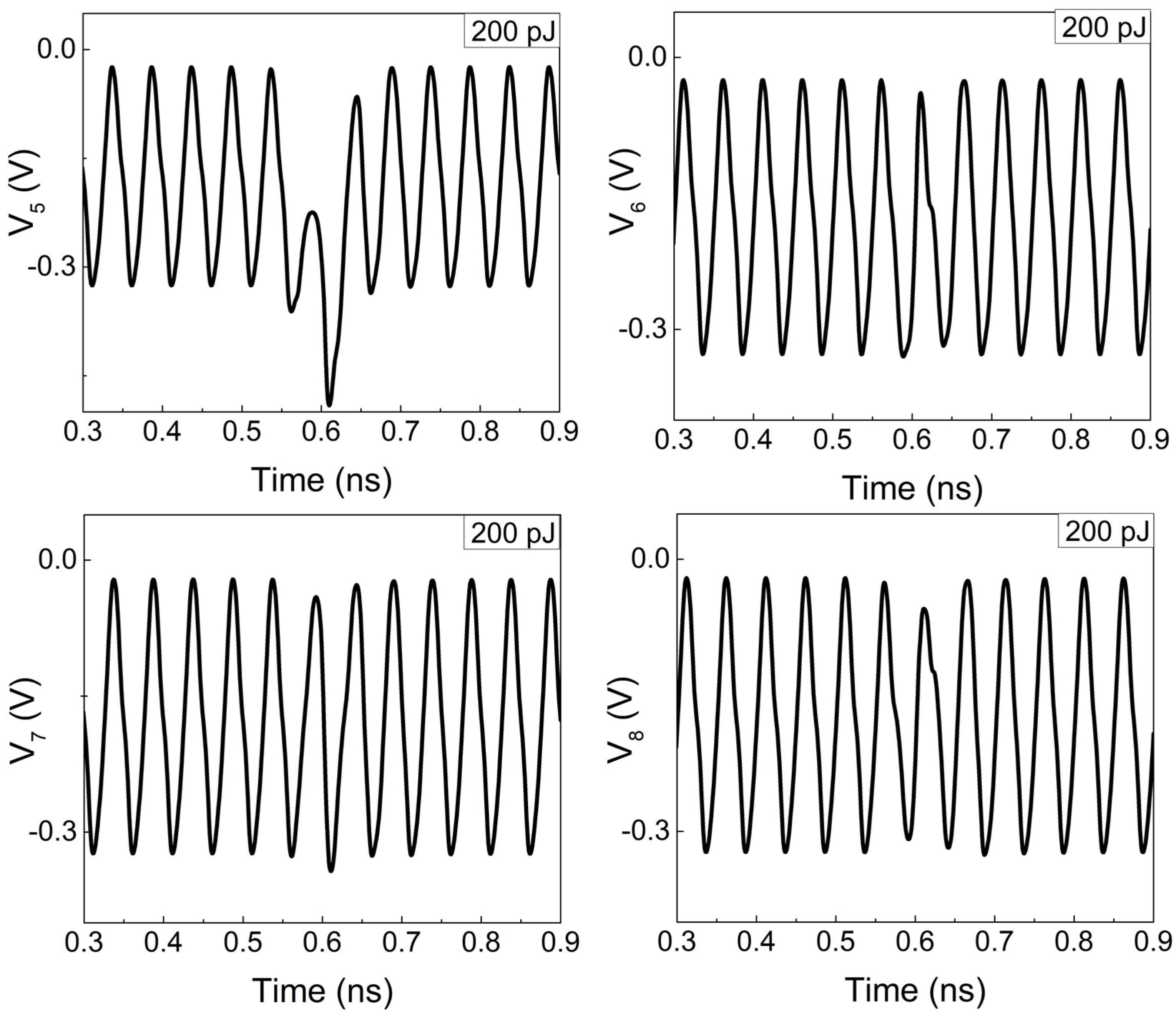
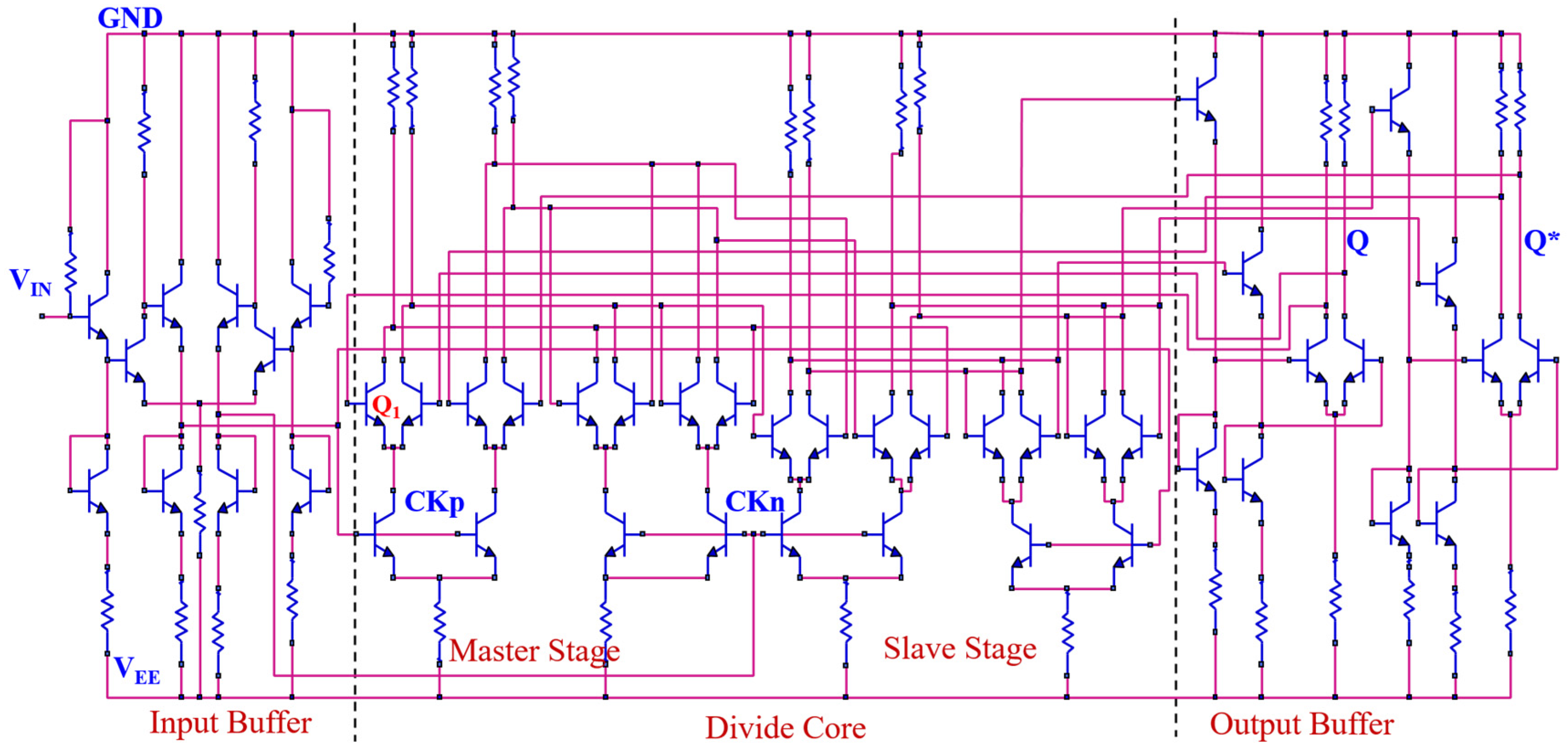
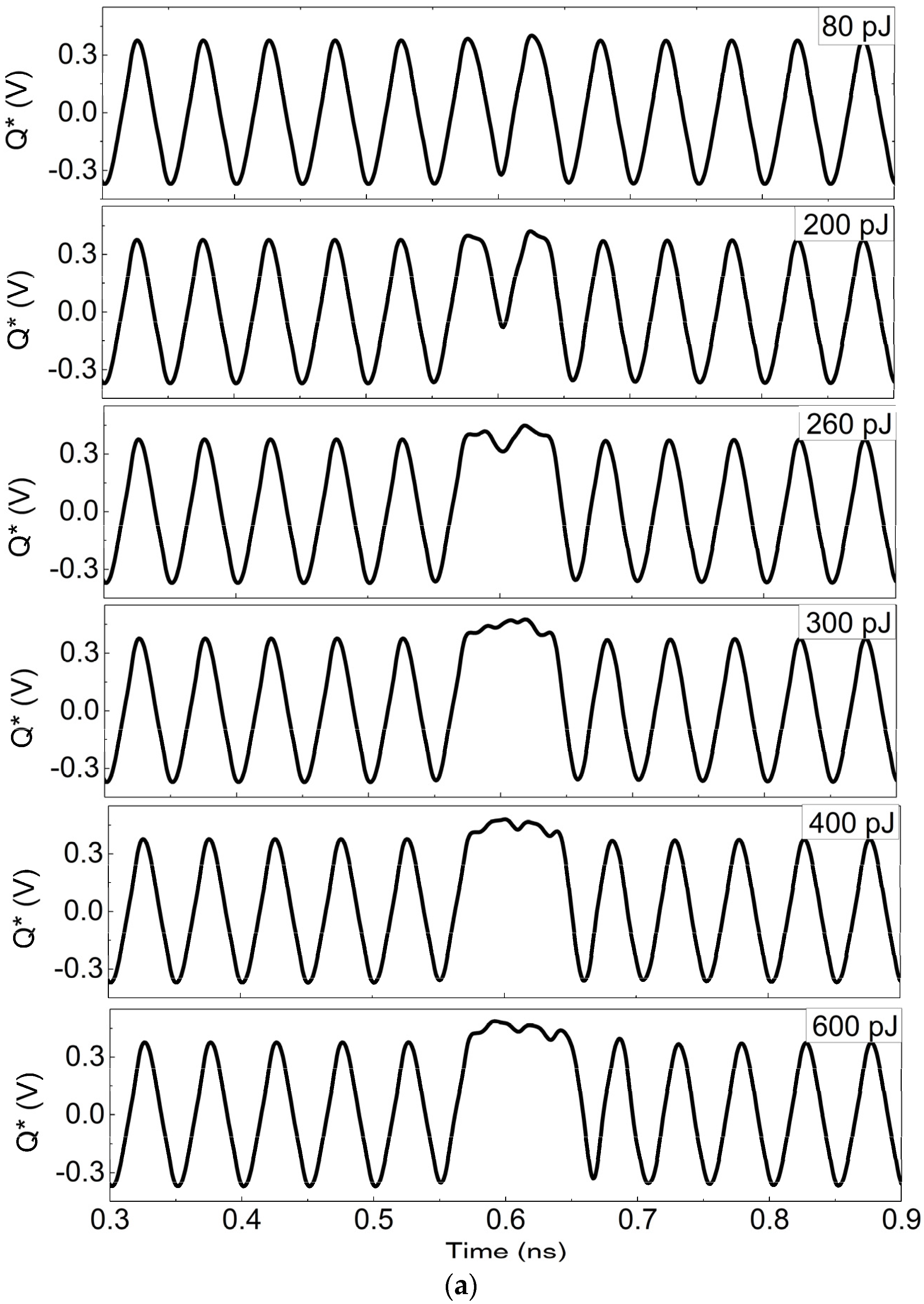
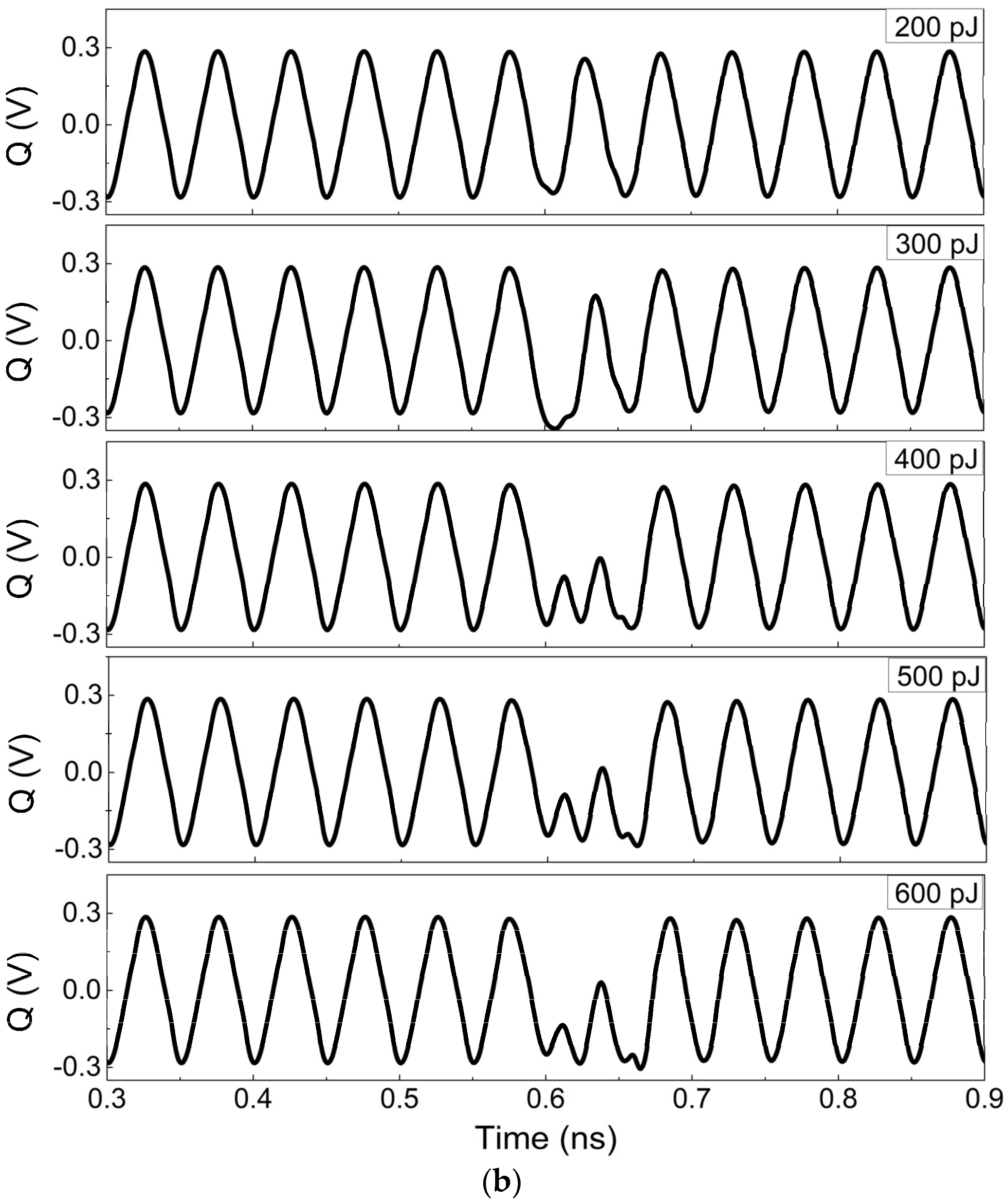
| Laser Energy (E) | T0 | t0 | w | P |
|---|---|---|---|---|
| 10 pJ | 9.62 × 10−6 A | 6.10 × 10−11 s | 4.31 × 10−11 s | 4.82 × 10−4 A |
| 15 pJ | 9.61 × 10−6 A | 6.05 × 10−11 s | 4.46 × 10−11 s | 0.00129 A |
| 50 pJ | 9.62 × 10−6 A | 6.04 × 10−11 s | 4.43 × 10−11 s | 0.00287 A |
| 80 pJ | 9.63 × 10−6 A | 6.03 × 10−11 s | 4.51 × 10−11 s | 0.00499 A |
| 100 pJ | 9.63 × 10−6 A | 6.10 × 10−11 s | 4.57 × 10−11 s | 0.00653 A |
| Incident Ions | |||||
|---|---|---|---|---|---|
| 59Ni | 80Br | ||||
| Laser Energy/pJ | Collected Charge/fC | Energy/MeV | LET/MeV/cm2/mg | Energy/MeV | LET/MeV/cm2/mg |
| 10 | 31.89 | 1.1 | 3.63 | 1.1 | 3.83 |
| 15 | 82.61 | 2.5 | 7.29 | 2.5 | 7.53 |
| 50 | 222.49 | 8 | 18.47 | 8 | 19.07 |
| 80 | 331.62 | 15 | 28.52 | 15 | 28.84 |
| 100 | 416.31 | 24 | 36.33 | 21 | 36.59 |
| References | Process | The Highest Input Frequency/GHz | The Number of Transistors | Power Dissipation/mW |
|---|---|---|---|---|
| Ref. [30] | 0.7 μm InP DHBTs | 83 | 30 | 620 |
| Ref. [31] | 0.7 μm InP DHBTs | 48 | 42 | 264 |
| Ref. [32] | 0.7 μm InP DHBTs | 43 | 42 | 230 |
| Ref. [33] | 0.8 μm InP DHBTs | 62 | 22 | 380 |
| Ref. [34] | 0.8 μm InP DHBTs | 40 | 30 | 650 |
| Ref. [28] | 0.8 μm InP DHBTs | 62 | 34 | 382 |
| Ref. [35] | 0.8 μm InP DHBTs | 66 | 42 | 424 |
| The unhardened circuit in this paper | 0.8 μm InP DHBTs | 58 | 28 | 219 |
| The hardened circuit in this paper | 0.8 μm InP DHBTs | 50 | 44 | 348 |
Disclaimer/Publisher’s Note: The statements, opinions and data contained in all publications are solely those of the individual author(s) and contributor(s) and not of MDPI and/or the editor(s). MDPI and/or the editor(s) disclaim responsibility for any injury to people or property resulting from any ideas, methods, instructions or products referred to in the content. |
© 2024 by the authors. Licensee MDPI, Basel, Switzerland. This article is an open access article distributed under the terms and conditions of the Creative Commons Attribution (CC BY) license (https://creativecommons.org/licenses/by/4.0/).
Share and Cite
Zhao, X.; Su, Y.; Chen, Y.; Zhang, Y.; Xiang, J.; Cheng, S.; Bai, Y. The Study on Single-Event Effects and Hardening Analysis of Frequency Divider Circuits Based on InP HBT Process. Micromachines 2024, 15, 527. https://doi.org/10.3390/mi15040527
Zhao X, Su Y, Chen Y, Zhang Y, Xiang J, Cheng S, Bai Y. The Study on Single-Event Effects and Hardening Analysis of Frequency Divider Circuits Based on InP HBT Process. Micromachines. 2024; 15(4):527. https://doi.org/10.3390/mi15040527
Chicago/Turabian StyleZhao, Xiaohong, Yongbo Su, You Chen, Yihao Zhang, Jianjun Xiang, Siyi Cheng, and Yurong Bai. 2024. "The Study on Single-Event Effects and Hardening Analysis of Frequency Divider Circuits Based on InP HBT Process" Micromachines 15, no. 4: 527. https://doi.org/10.3390/mi15040527
APA StyleZhao, X., Su, Y., Chen, Y., Zhang, Y., Xiang, J., Cheng, S., & Bai, Y. (2024). The Study on Single-Event Effects and Hardening Analysis of Frequency Divider Circuits Based on InP HBT Process. Micromachines, 15(4), 527. https://doi.org/10.3390/mi15040527





